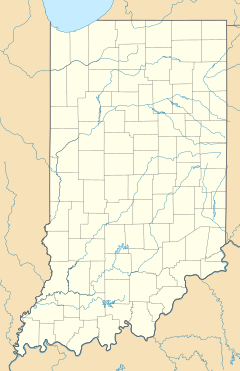Weaver, Indiana facts for kids
Quick facts for kids
Weaver, Indiana
|
|
|---|---|
| Country | United States |
| State | Indiana |
| County | Grant |
| Township | Liberty |
| Elevation | 873 ft (266 m) |
| ZIP code |
46953
|
Weaver is a small, unincorporated community located in Liberty Township, Grant County, Indiana. It was first settled in the early 1840s by free people of color. These settlers moved to Grant County from North Carolina and South Carolina. The area was first called Crossroad. Later, it was renamed Weaver to honor a well-known family in the community.
Weaver grew quite a bit in the late 1800s. Its population was said to reach 2,000 people. Many residents later left for better jobs in bigger towns during Indiana's natural gas boom. However, over 100 families still lived there in the early 1920s. Today, Weaver is no longer a separate community. But the Weaver Cemetery remains an important landmark.
Contents
The Story of Weaver: A Pioneer Community
Weaver was one of Indiana's first communities for black pioneers. It started in the 1840s. The first settlers were free people of color and former slaves. They came from North Carolina and South Carolina. In 1847, with help from Aaron Betts, a white Quaker from Ohio, people like Billy Clark and John Wright settled in Grant County.
Early Settlers and Growth
Byrd Weaver, a free person of color, was another early settler. He arrived around 1847 and is listed in the 1850 census for Grant County. Other early families included the Pettiford family, who were also free people of color. Both the Weavers and Pettifords originally came from North Carolina. Later, more people moved to Weaver from Wayne County, Randolph County, Indiana, and Chillicothe, Ohio. William Wood was one of the richest landowners in Weaver. Byrd Weaver was known for helping new settlers come to the community. Other members of the Weaver family held important jobs, like postmaster and storekeeper.
Weaver grew as a farming community in the 1850s and 1860s. In 1850, only three African American families lived in Liberty Township. One of these was led by Byrd Weaver. By 1860, the black population in the township had grown to 284 people. The community kept attracting new people during the American Civil War. This included freed and escaped slaves. Some Weaver residents farmed their own land. Others worked on farms owned by their white neighbors. Most men in Weaver were farmers. But some also offered other services. Beverly Pettiford was a farmer and a shoemaker. Jack White was a farmer who played the violin at community events.
Life in Weaver's Peak Years
Weaver eventually had its own school, church, general store, and blacksmith shop. The community was at its busiest in the 1870s and 1880s. Its population was reported to be almost 2,000 people. A post office opened in Weaver in 1880. It stayed open until 1902.
Changes and Decline
In the 1880s, Grant County had a "natural gas boom." This meant many people from rural areas, including Weaver, moved to bigger industrial towns. They went to places like nearby Marion and Gas City. They hoped to find better-paying jobs. The Indiana gas boom also led to changes in how people in Grant County thought. There was an increase in racial tension. In the early 1900s, Weaver's population continued to shrink. However, over 100 black families still lived there in the early 1920s. Most of Indiana's early black rural settlements, including Weaver, no longer exist as they once did.
Where is Weaver Located?
Weaver was built in the northern part of Liberty Township, Grant County, Indiana. Several streams flow through this area. These include Big Deer, Grassy Fork, and Middle Fork Creeks. The township is known for its flat land and rich soil. Like other early black settlements in Indiana, Weaver was started near Quakers. Quakers were known for being strongly against slavery.
Who Lived in Weaver?
Weaver was founded by free black people and former slaves. Its population grew in the late 1840s and early 1850s. The community reached its largest size in the late 1800s. At that time, about 2,000 people lived there. Many residents were related to each other. For example, the Weaver family had sixty members living in sixteen different homes by 1860. The area was first called the Crossroads. But it was later renamed Weaver because so many residents had the Weaver last name. Other families in Weaver had names like Smith, Hill, Pettiford, Burden, Ward, Jones, Wood, Guillford, Artis, and White. Weaver started to get smaller in the early 1900s. It no longer exists as a separate community today.
Education in Weaver
The children in Weaver went to Weaver School. This was a one-room schoolhouse. Its official name was Liberty Township School Number 2. It opened in 1869. This public school was only for black students. It served as both a place for learning and a community center. West School, another township school, was built one mile west of Weaver School.
Religion in Weaver
The African Methodist Episcopal Church (AME) congregation in Weaver built Hill's Chapel in 1849. Other churches near the Weaver community included a Baptist church, built in 1854. There was also a Wesleyan church, built in the 1870s.
Getting Around Weaver
A gravel road was built east of Weaver in 1869. This new road replaced an older corduroy road. The old road connected Liberty Township to Marion, which is the main town in Grant County.
Places to See in Weaver
The Weaver Cemetery is still an important landmark in the community.



